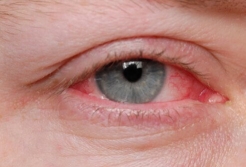Fungal Eye Infections
Published on 09/23/2019
The most common way for someone to get a fungal eye infection is because of an eye injury, particularly if plant material such as a stick or a thorn caused the injury.

Some fungi that cause eye infections, such as Fusarium, live in the environment and are often associated with plant material. Fungi can enter the eye and cause infection after an injury.
Less often, infection can occur after eye surgery such as corneal transplant surgery or cataract surgery.
Timely identification and treatment of fungal eye infections are paramount
This is a comprehensive review of the fungal and parasitic diseases of the eye. Numerous fungi and parasites infect the eye either by direct introduction through trauma or surgery.
The unique structure of the human eye as well as exposure of the eye directly to the environment renders it vulnerable to a number of uncommon infectious diseases caused by fungi and parasites. Host defenses directed against these microorganisms, once anatomical barriers are breached, are often insufficient to prevent loss of vision. Therefore, the timely identification and treatment of the involved microorganisms are paramount.
Published in the following categories: Medical Mycology Dermatophytes Clinical